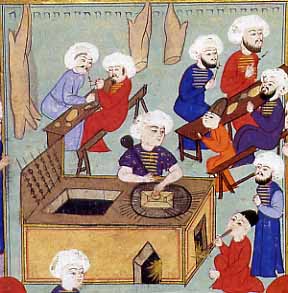
There are many cuisines in the Middle East and Central Asia and one of the great fusion examples occurred in the Ottoman Empire. In a recent book (500 Years of Turkish Cuisine) published in Turkey, Marianna Yerasimos provides a colorful survey of the various foods and drinks along with recipes and an array of images from Turkish illuminated manuscripts. Here is a sample from her introduction (with recipes to follow on future days):
“No one influence alone, central Asia, Anatolia or Byzantium, is by any means enough to explain Ottoman cuisine and its extraordinary richness in terms of ingredients and variety of dishes. As you will see in the recipes, especially in the 15th and 16th centuries, Ottoman cuisine shared ingredients, cooking methods and dish names with the Middle East. As there are inadequate sources available, it is at least for the time being impossible to definitively determine what it shared with Byzantine cuisine. There are also other veins fat and thin, which nourished Ottoman cuisine, such as Rumelia (the part of the Ottoman empire which was in Europe) and the Balkans.
Before the gourmets protest, let me conclude this comment with the general truth that as the last sovereign power in the region and one of the longest surviving empires, the Ottoman empire, as is the case in many regions, was the meeting place of the influences of various culinary cultures.
The main categories of dishes in Ottoman cuisine are the following: kebabs of meat and fowl; sweet-sour meat dishes cooked with fruit and sometimes with legumes; plain and combination pilavs; dough-based dishes; boreks; meat dishes with vegetables and stuffed vegetables; soups; many kinds of sweets. There are a small number of fish dishes, and salads, pickles and cheeses eaten by way of meze (hors d’oeuvres)…
That was a list of the food, so what about drink? Water was not drunk at the tables of wealthy Ottomans. When a drink accompanied a meal it would be stewed fruit or sherbet. As you will see in the sweets section of the book, sherbets were an ever-popular drink made from flowers, fruit, sugar and honey, and were enjoyed by all whatever the season. Another popular drink, drunk mostly in winter months, was boza. Made from white millet, boza was made by chefs of the helvahanes of the palace and mansions, but also by Albanians in Istanbul, who wandered the streets of the city at night selling it from a skin or large copper jug.
Alcohol was little consumed as it was forbidden by religion, but it would be naive to say that no Muslim drank alcohol. We know that in the big cities such as istanbul, two strata of society, the lowest, especially sailors and fishermen, and the well-off educated would, mostly clandestinely, drink wine and raki, but sometimes openly, at festivals proclaimed by the Sultan (for weddings, births, etc), for example, when such ‘favours’ would be granted by him, a blind eye would be turned to the gaiety of Muslim men in the city. There are even poems written in praise of wine.â€
[Excerpt from Marianna Yerasimos, 500 Years of Ottoman Cuisine (Istanbul: Boyut Publishing Group, 2005), translated by Sally Bradbrook, pp. 11-12.]